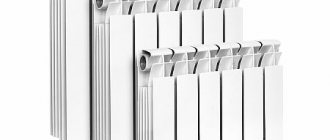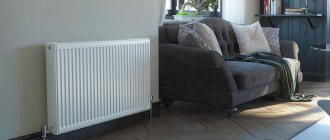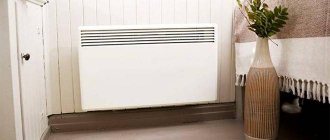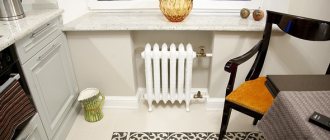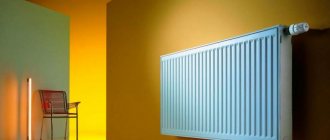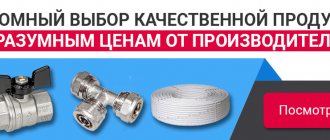Cast iron heating radiators are well known to residents of the Soviet and post-Soviet countries.
Despite the fact that many people have switched to structures made of other metals due to the heavy weight, some people still prefer cast iron. And for good reason - in terms of reliability and some other parameters, they are significantly superior .
Especially when you consider that modern models have a beautiful appearance.
Let's look at the TOP of the best cast iron radiators, what to look for when choosing a heating device.
Rating of the TOP 8 best cast iron heating radiators
| Place | Model | Price |
| The best wall-mounted models | ||
| #1 | Konner Modern 500 | |
| #2 | STI Nova 500 x10 | |
| #3 | RETROstyle TOULON 900/70 | |
| #4 | Ogint Fortis 500 | |
| #5 | Ogint Fortis 500 | |
| The best models with floor installation | ||
| #1 | Iron Lion Azalia 950 | |
| #2 | RETROstyle BRISTOL 800 | |
| #3 | RETROstyle DERBY M 320 | |
Page navigation:
MS-140 – main parameters
Today, of all the models that were installed at one time in apartment buildings, the most popular of them remains - MS-140. The lowest center distance had cast iron radiators 300 mm, and the highest - 800 mm. Currently, factories produce only batteries of two parameters - MC 500 and 300.
Basic indicators:
- Working pressure 9 atmospheres.
- Heat dissipation up to 175 W.
- Consists of two-channel sections.
- The cast iron radiator 500 has a height of 50 cm and a width of 9.8 cm.
- The coolant volume is 1.35 l.
- Heating of the coolant up to +130 degrees.
Thanks to these parameters, the MS-140 is in demand among the population. A significant role in this is played by its low cost and high reliability, proven over decades.
What characteristics should you pay attention to when choosing a cast iron radiator?
Be on the lookout! Cast iron batteries have a number of parameters that you should pay special attention to when purchasing:
- Connection type. Today, stores offer devices with predominantly side connections. This is the most convenient and practical option, as it allows the radiator to warm up evenly.
- Design. It can be floor or wall mounted. Wall-mounted radiators are more familiar to consumers, because they can easily be installed on the wall under the window sill. As for floor structures, they are no less practical: they do not take up much space and do not require a load-bearing wall nearby.
- Heat dissipation. This indicator determines the efficiency of the radiator. The higher it is, the larger the room it can warm up.
- Dimensions. Before buying a radiator, you need to measure the place where it will be installed.
Installation
To begin with, let’s make a reservation that it is possible to install cast iron heating radiators with your own hands, but this will not be easy to do, because the heating structure is quite heavy. You will most likely need a partner.
The method of connecting the battery and pipe will not be the same as with aluminum or bimetallic counterparts, where the connection is made using threads. In the case of a cast iron device, gas welding is used. Before starting work, you should prepare all the tools that may be useful. Installation of cast iron heating radiators will require:
- gas welding;
- set of keys;
- level;
- tape measure and regular pencil;
- hammer drill.
As for the materials that will be needed to mount cast iron heating radiators to the wall, it is worth stocking up on:
- a set of radiators of the required size;
- seal;
- fittings (tees, plugs);
- Mayevsky crane;
- brackets (mounting for cast iron heating radiators).
Installation of a cast iron heating radiator
- To get started, you should disassemble the cast iron radiator that was originally installed. Take an angle grinder and slowly disconnect the heating structure. Before doing this, make sure that the heating system is turned off and the remaining water is drained from the pipes.
- The next step is to determine a place on the wall to place the device. By mounting the battery exactly in the center of the window, you will achieve the necessary circulation of air masses in the room. Take measurements along the width of the window. This will determine the center of the radiator installation. This is easy to do by drawing a central vertical and horizontal line. Do everything as accurately and carefully as possible, this way you will avoid the formation of air jams. Markings for brackets for cast iron heating radiators are also required.
- After the necessary markings, you need to install the brackets and “hang” the radiator on them. Use a drill to make holes according to the markings and carefully secure the dowels. Screw in the holders. If the installation is carried out correctly, the radiator will be firmly fixed on all four supports.
- Now it's time to connect the battery to the heating system. The cut section of the pipe must be shortened to the required length on one side. Remember about bending the pipe! On the other side, replace the plug with a shut-off valve. This action will ensure in the future to reduce or increase the flow of fluid. The valve must be screwed to the battery using sealing tape or tow. Close everything so that there are no leaks in the future. Bend the open pipe ends and connect them using gas welding, thereby ensuring a strong seal. The welding gap must be thoroughly cleaned with sandpaper. After this, cover the surface with paint.
If desired, install a tap that will shut off the liquid supply, not forgetting about installing a bypass system. It will make it possible to switch off water only in your premises and you will not depend on your neighbors.
Thus, cast iron heating radiators are connected.
The best wall-mounted models
Wall installation of a cast iron radiator is the most common and easiest way. Among the advantages of such structures it is worth noting:
- high heat transfer rate due to the large area of contact with air;
- variety of sizes, shapes, designs - you can choose according to the interior of the room;
- high heating speed;
- ease of installation;
- saving space under the window.
Keep in mind! As for the disadvantages, these include:
- uneven heating of the room - warm air accumulates in the ceiling area, the floor still remains cold;
- it is impossible to unnoticedly route pipes to the radiator;
- heavy weight, not suitable for plasterboard walls.
TOP 5 best models with wall installation in terms of price and quality ratio.
Konner Modern 500
The perfect combination of style and high quality heating .
The outer surface is perfectly processed - has no unnecessary bulges. Therefore, it fits easily under the window sill to the wall.
It is compact and can be hidden well under a curtain, although it can become a harmonious element of a room interior.
In appearance, this model is similar to the standard aluminum one, but is superior in quality.
Specifications:
- connection - lateral;
- type - sectional;
- maximum operating pressure - 12 bar;
- height - 60 cm;
- width of one section - 6.4 cm;
- thickness - 9.6 cm;
- the weight of one section is 4.9 kg.
Advantages
- beautiful exterior;
- rich equipment;
- good heat dissipation;
- versatility;
- endurance;
- reliability.
Flaws
- the coating is easily scratched;
- not very high quality painting, sagging is visible;
- high price.
STI Nova 500 x10
Sectional radiator with a laconic design and high quality workmanship.
The device is made of cast iron, but in appearance it does not differ from modern radiators.
Able to withstand high coolant temperatures, as well as increased short-term pressure.
With its help, you can fully heat a room up to 20 square meters in size.
Specifications:
- connection - lateral;
- type - sectional;
- maximum operating pressure - 12 bar;
- height - 58 cm;
- width of one section - 6 cm;
- thickness - 8.5 cm;
- weight - 42 kg.
Advantages
- low weight as for a cast iron product;
- modern design;
- quickly warms up the room;
- high-quality coating;
- low price.
Flaws
- not the most convenient standard width, it is better to buy in separate sections;
- difficult to install in rooms with plasterboard walls;
- the paint chips easily - must be protected from mechanical damage.
RETROstyle TOULON 900/70
This cast iron radiator is made in a retro style, so it will ideally complement the interior of the corresponding theme.
Despite the fact that the dimensions of the radiator cannot be called compact, it will harmoniously fit into a room designed in a loft or retro style.
Withstands pressure up to 15 atmospheres, which is quite suitable for an apartment and will ensure a long service life.
Specifications:
- connection - lateral;
- type - sectional;
- maximum operating pressure - 10 bar;
- height - 98 cm;
- width of one section - 6 cm;
- thickness - 7 cm;
- the weight of one section is 6.1 kg.
Advantages
- original appearance;
- low price;
- long service life;
- ease of maintenance;
- reliability.
Flaws
- the build quality is not always high - the joints are visible;
- the surface is subject to mechanical damage;
- heavy weight;
- The radiator on the back side is poorly painted.
Ogint Fortis 300
A universal device with a modern exterior that can be used in rooms for any purpose.
The design consists of 10 elements, which is very convenient - no need to calculate the required size.
All radiators of this model come with the same dimensions.
The compact size allows you to fully heat medium and small rooms.
Specifications:
- connection - lateral;
- type - sectional;
- maximum operating pressure - 12 bar;
- height - 38 cm;
- width - 58 cm;
- thickness - 8 cm;
- weight - 28 kg.
Advantages
- compact size;
- a light weight;
- low cost;
- modern design;
- versatility;
- availability of protection against water hammer.
Flaws
- not sold in separate sections;
- poor equipment;
- The surface gets scratched quickly.
Ogint Fortis 500
Cast iron radiator with a modern appearance and high quality.
This model is similar to Ogint Fortis 300, only it has a greater height.
Therefore, this design is suitable for heating rooms with dimensions of more than 20 square meters.
It will successfully fit into the interior of any style - both classic and modern.
Specifications:
- connection - lateral;
- type - sectional;
- maximum operating pressure - 12 bar;
- height - 58 cm;
- width of one section - 5.8 cm;
- thickness - 8 cm;
- the weight of one section is 4 kg.
Advantages
- reliability;
- water hammer protection;
- a light weight;
- low cost;
- modern design;
- versatility.
Flaws
- poor equipment;
- the surface is easily subject to mechanical damage;
- bulky design.
Reviews ↑
Users agree that the best heating radiators for apartment buildings are cast iron. They are the most reliable and durable, and are also not picky about the quality of the coolant and are able to transfer more heat than other types (in case of insufficient heating of the coolant). Users note their ability to retain heat for a long time when the heating is turned off. Owners of private houses rarely choose cast iron radiators; it is easier for them to buy aluminum ones as the cheapest option. An autonomous heating system allows you to control the quality of the water (coolant) and not drain it in the summer, so installing aluminum batteries allows you to save significantly. Regarding the choice of brand, many users are inclined to domestic ones due to their low cost. But users argue with them, considering these models to be outdated and too similar in design to old Soviet batteries. They suggest considering Czech or Turkish radiators, which have a more attractive appearance. According to our experts, Chinese “Conner cast iron radiators” are the most frequently requested product on the Internet, mainly interested in their price.
The best models with floor installation
Note! Floor-mounted radiators are the best option for those with panoramic windows.
In such cases, installation of wall structures is not possible. Advantages of floor-standing devices :
- Compact dimensions. These are the smallest devices that can be found on the heating market.
- Exterior. Modern designs are made in a universal style and will not spoil even the most sophisticated interior.
- Wide range of colors. If wall-mounted radiators are produced predominantly in white, then floor-standing units can be made in different shades. There are models with a textured pattern like wood or granite.
- Easy installation. The batteries are installed on legs - pipes coming from the floor or walls.
- Possibility of heating large rooms.
Disadvantages of floor radiators:
- pipe routing must be done in the floor, otherwise installation difficulties will arise;
- heating is carried out only by convection method;
- high price.
Let's consider the best models of cast iron radiators with floor installation.
Iron Lion Azalia 950
An original device made in retro style.
When choosing this model, you should take into account the design of the room in which it is to be installed.
After all, retro will not suit such styles as hi-tech, minimalism, modern, etc.
As for functionality, this is a truly high-quality heating device that produces heat quickly.
Specifications:
- connection - lateral;
- type - sectional;
- maximum operating pressure - 10 bar;
- height - 95 cm;
- width of one section - 7 cm;
- thickness - 14 cm;
- the weight of one section is 11 kg.
Advantages
- unusual design;
- ease of installation;
- rich equipment;
- quickly heats the room;
- reliability.
Flaws
- heavy weight;
- high price;
- not a universal exterior.
RETROstyle BRISTOL 800
An unusual model with an embossed pattern over the entire surface.
The radiator is made in a dark color, which allows you to visually save space in the room.
The original design of the structure will simply become the star of the room, since not every battery can boast of such an exterior.
Specifications:
- connection - lateral;
- type - sectional;
- maximum operating pressure - 10 bar;
- height - 96 cm;
- width of one section - 8 cm;
- thickness - 25 cm;
- the weight of one section is 18.6 kg.
Advantages
- unusual exterior;
- high heat transfer;
- rich equipment;
- high build quality;
- Scratches, chips, and mechanical damage are not visible on the surface.
Flaws
- high price;
- bulky design that needs to be played up in the interior;
- heavy weight.
RETROstyle DERBY M 320
A model with a discreet design, made in black.
The radiator is a continuation of the Soviet and post-Soviet classics.
There were batteries of almost the same shape in every apartment, only white.
The device quickly heats large rooms and has a long service life.
Specifications:
- connection - lateral;
- type - sectional;
- maximum operating pressure - 10 bar;
- height - 48 cm;
- width of one section - 6.3 cm;
- thickness - 17.4 cm;
- the weight of one section is 5.5 kg.
Advantages
- acceptable price;
- quickly warms up the room;
- relatively light design;
- uniform coverage;
- long service life.
Flaws
- Even small scratches are visible on the surface;
- not always high-quality assembly;
- The design will not be to everyone's taste.
How to correctly calculate the power of a cast iron battery for installing it in one room
In order for the radiator to please the owner with its efficiency, it is necessary to correctly calculate its power. Here it is necessary to approach the calculations as competently as possible. If this is not done, the heated room may turn out to be too hot or quite cool. We will tell you how to make calculations in this section.
Low-power compact cast iron radiator of a modern type Source eco-kotly.ru
Section counting
The number of sections of cast iron radiators that you will install directly depends on its heat transfer and volumetric characteristics of the room. Basically, the area of the room is taken into account here, but it is also important what the height of the ceiling is, how many windows and doors there are in the room, etc. Under standard conditions (ceilings no higher than 3 m), the required power is calculated at the rate of 1 kW of energy for every 10 m2. Further, the characteristics of the device data sheet and a simple arithmetic calculation will give you the number of sections you require. If there are non-standard conditions, it will be enough to add 1-2 extra sections.
Attention! Even if you have experience in installing radiators, it is better to call the appropriate services for this, especially for the reconstruction of central heating systems. This guarantees installation quality and long service life of the system.
Installation

